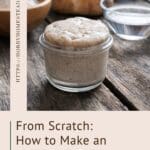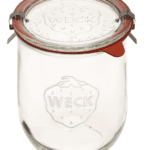From Scratch: How to Make an Easy Sourdough Starter
An easy sourdough starter is made from a mixture of flour and water that captures wild yeast from the environment, which will naturally ferment to become the base for many tasty sourdough breads.
Servings: 2 cups
Calories: 204kcal
As an Amazon Associate I earn from qualifying purchases.
Ingredients
- 1 Cup Whole Wheat Flour rye flour, or all-purpose flour.
- 1/2 Cup Lukewarm Water We use filtered well water. Bottled water works well too.
Instructions
Day 1: Start Your Sourdough Journey
- In a clean jar, combine 1 cup of flour and 1/2 cup of water. Stir with a wooden spoon until well mixed. Cover loosely with plastic wrap or a lid, and leave it in a warm place, ideally at room temperature. This will allow the wild yeast to start growing.1 Cup Whole Wheat Flour, 1/2 Cup Lukewarm Water
Day 2-3: Feed Your Starter
- Each day, discard half of the starter (this is called sourdough discard), and feed it with 1 cup of fresh flour and 1/2 cup of water. Mix well and place the jar back in its warm spot. By the next day, you should see lots of bubbles—a good sign of fermentation! This feeding schedule will help the fermentation process build strength.
Day 4-5: Look for Activity
- Continue feeding your new starter daily. By this point, the starter should rise and fall predictably. You can use a rubber band around the jar to track its rise. For best results, keep it at room temperature. As the wild yeast becomes more active, your sourdough starter will be almost ready.
- Float Test. You can also do a float test by dropping a bit of starter in water. If it floats, you’ve got an active sourdough starter.
Day 6-7: Your Starter is Ready!
- After about a week, you should have an active starter that's bubbly, smells pleasant, and is ready for baking. Use it in your favorite sourdough bread recipe or other sourdough recipes like sourdough pancakes or english muffins. Once the fermentation has started keep feeding it with equal parts water and flour for regular feeding.
Notes
Storing Your Sourdough Starter
If you bake often, keep your starter at room temperature and feed it once or twice daily. If you bake less frequently, store it in the fridge and feed it once a week to maintain an active starter.Nutrition
Calories: 204kcal | Carbohydrates: 43g | Protein: 8g | Fat: 2g | Saturated Fat: 0.3g | Polyunsaturated Fat: 1g | Monounsaturated Fat: 0.2g | Sodium: 4mg | Potassium: 218mg | Fiber: 6g | Sugar: 0.2g | Vitamin A: 5IU | Calcium: 22mg | Iron: 2mg


